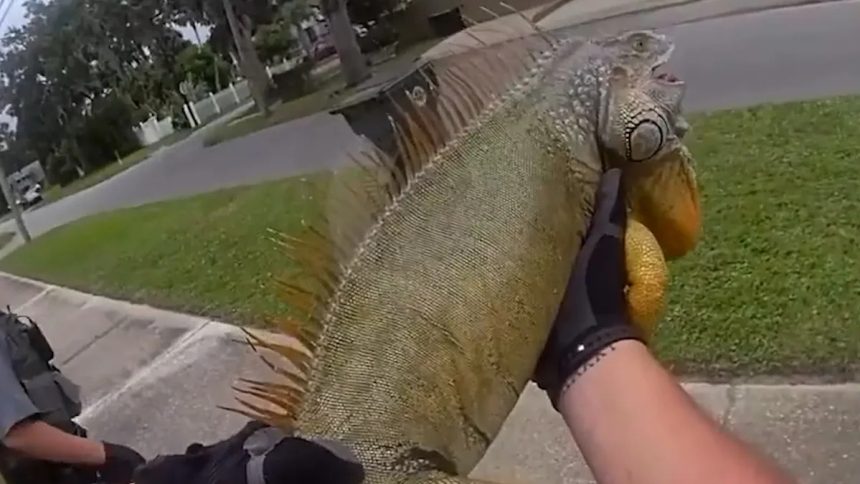Daytona Beach Police responded to a large iguana roaming around and disrupting a neighborhood late Monday morning.
In a video shared by the department on Facebook, officers “arrest” and take the squirming reptile into custody, but not without a fight.
“ANIMAL PLANET – DAYTONA EDITION,” the caption reads. “Just another day on patrol! Our officers responded quickly to help safely capture an unexpected visitor, an iguana found roaming around Daytona Beach. Thanks to quick teamwork, the situation was handled.”
The scaly suspect even had a mock mugshot taken and was “charged” with disorderly conduct, resisting arrest, trespassing and fleeing.
More: Can you shoot a wild animal on your property in Florida? What to know about wildlife, gun laws
Watch Daytona Beach officers arrest huge, scaly iguana
Is it common to see iguanas in Florida? Are they native?
Though green iguanas are native to Central America, parts of South America, and some Caribbean islands, they’re found in many Florida counties along the Atlantic and Gulf coasts.
The species was first reported in the state in the 1960s in Hialeah, Coral Gables and Key Biscayne, after they were accidentally brought in cargo ships from Cuba, according to Florida Museum.
Now, populations can be found mainly in the southern half of the state, in Broward, Martin, Miami-Dade, Monroe, Palm Beach, Collier and Lee counties, with some reports farther north.
Why are iguanas a problem in Florida?
Since green iguanas are not native to Florida and pose a threat to native wildlife, they are considered an invasive species, according to the Florida Fish and Wildlife Conservation Commission.
Green iguanas have been found to have consumed tree snails at Bill Baggs Cape Florida State Park and nickerbean at Bahia Honda State Park, further suggesting the threat the iguanas pose to native and endangered species.
The reptiles are often considered a nuisance by property owners, per the FWC. They dig burrows that can erode sidewalks, are attracted to trees with foliage or flowers, and leave droppings that can transmit Salmonella to humans through contaminated surfaces.
Green iguanas bask on the Lake Worth Community High School pool deck in Lake Worth Beach, Fla., on December 4, 2024. The iguanas navigate their fecal detritus that has caused the pool closure.
How to report sightings of nonnative species in Florida
According to the FWC, there are three easy ways to report sightings of nonnative species
-
IveGot1 app: The free app is available for iPhones and Androids. Reporting nonnatives using the IveGot1 app is preferred for lower priority species, such as small nonnative lizards and iguanas.
-
Online at IveGot1.org: The online form will prompt you for the information and has a map where you can select the location if you do not have the GPS coordinates. You will need to create a free account the first time you report a sighting online. Reporting nonnatives using the IveGot1 website is preferred for lower priority species, such as small nonnative lizards and iguanas.
-
Invasive Species Hotline: Call 888-Ive-Got1 (483-4681). FWC asks the public to call the hotline to report high priority species, including all nonnative snakes, monitor lizards, and tegus. Hotline hours are from 8 a.m. – 5 p.m. five days a week and features a voicemail system if the operator is unable to answer the call or for calls placed after normal operating hours.
This article originally appeared on The Daytona Beach News-Journal: Florida police ‘arrest’ massive iguana in Daytona Beach: Watch video









